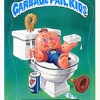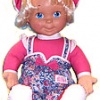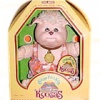Innocent-looking it may be, but parents everywhere would never again underestimate the pulling power of a pair of pudgy stuffed arms and too-closely set eyes. Never again would they spend the weeks before Christmas waking up in a cold sweat because they couldn't - for love nor money - find a toy store that had any in stock. What am I talking about? The year of 1983, that's what, and the Cabbage Patch Kids craze (or curse, as parents might refer to it).
The Cabbage Patch Kids - not to be confused with the poor imitation Flower Patch Kids, which didn't even have separate fingers - didn't hit the big time straightaway, though. In the beginning, they had been the subjects of an art exhibition created by scuptor, Xavier Roberts. He used German fabric sculpting and quilting methods to produce his (originally termed) 'Little People', which he'd sell at various arts and crafts fairs to substitute his art school fees. Roberts later opened up an area of Babyland General Hospital as a 'birthing' and rehoming department for his Cabbage Patch Kids. Here, people would come to buy their own doll, and even today tourists flock to the site in Georgia, US.
As the popularity of the dolls grew, in 1982 Roberts partnered up with toy manufacturer Coleco to meet demand from the masses (this had been given an unexpected boost with an appearance on reality TV show Real People in the US).
By modern standards, these dolls were rather ugly, with pudgy, round faces, stumpy arms and small, close-set eyes. What seemed to draw kids to them, however, was their uniqueness - a point that was cleverly marketed and made the dolls stand out. Each doll came with its own birth certificate for its new owner to keep in pride of place, so each Cabbage Patch Doll also had its own unique name. Once the adoptive parents (the doll's new owners) filled out the included paperwork and sent this off to the manufacturer, they would then receive a first birthday card in the post! And as if they weren't unique enough, the computer-controlled manufacturing process randomly made small changes to each doll so that no two dolls were the same.
Despite rioting in the aisles as parents fought to get the last Cabbage Patch Doll in the run up to Christmas, the dolls were discontinued in 1989. Hasbro took over production from this point, adding a number of gimmicks, such as ones wit kazoos they could play. Unsurprisingly, this didn't take off, so in 1994 Mattel took over the Cabbage Patch Kid license. The most revolutionary change Mattel made to the dolls was making some available in vinyl - making for much more durable playmates. In 1996, there was also a range of Olympiakids released to cash in on the Olympics that year.
The Talking Cabbage Patch Kid was a side line launch that was perhaps a bit ahead of its time (something Furbys would later get spot on). The price tag for owning a doll that was able to detect the presence of another doll and converse with it without any human interaction was pretty steep back then, plus there was the added price for many of the nightmares that would come from owning such a 'toy'.
In 2003 Toys R Us had its chance to make a mark on Cabbage Patch Kids. It decided to produce 20-inch kids (compared to the usual 14 inches) - in celebration of 20 years of Cabbage Patch Kids.
But enough of the facts. What everyone wants to know is: were they worth the bruises, Mum? Of course they were.










Do You Remember Cabbage Patch Dolls?
Do You Remember Cabbage Patch Dolls?